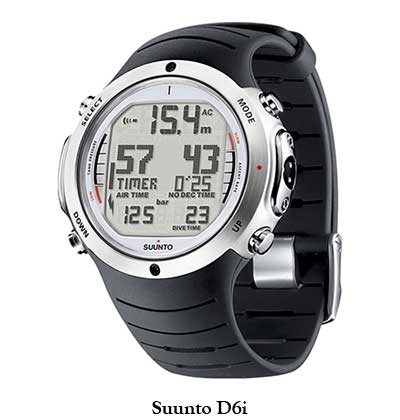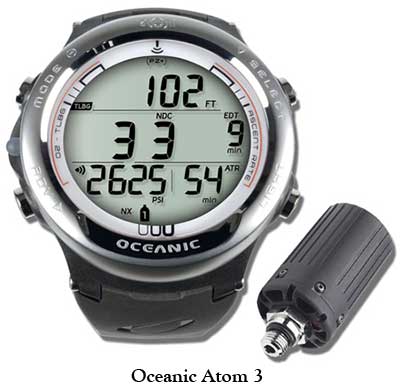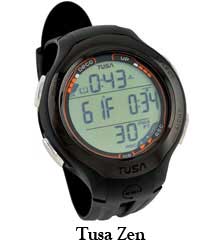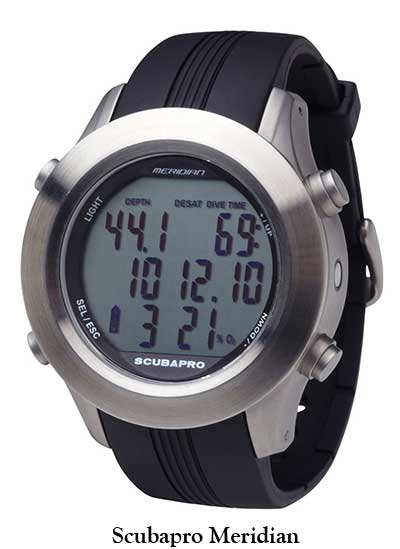Comparing Dive Computer WatchesContents of this Issue: Kasai Village, Cebu, Philippines Belize, Hawaii, Cozumel, Palau . . . The Reason for Wrinkled Fingers A Lost–at-Sea Diver Tells His Tale Comparing Dive Computer Watches Chinese Price Gouging and DCS Too Dead Divers’ Bad Mistakes: Part I Hey, There’s an App for that Dive Don’t Call Them “Shark Attacks” Anymore Editorial Office: Ben Davison Publisher and Editor Undercurrent 3020 Bridgeway, Suite 102 Sausalito, CA 94965 Suunto, the originator, versus everyone else from the March, 2013 issue of Undercurrent
In 1997, the Finnish company Suunto first made a deco computer doubling as a watch, calling it the Spyder. Suunto later added a nitrox logarithm and the Stinger was born. Now there is a plethora of computer watches to choose from -- if you're going to the trouble to develop a diving computer, why not make one as a computer-watch variant too? Suunto still dominates in Europe and Asia, but Oceanic's associated company, Pelagic, is popular in the Americas. And now Scubapro and Mares have their own ideas of how it should be done. Let me offer a comparison of key models, in case you are in the market. Suunto Computer Watches Not to be outdone, Suunto offers gas-integration by radio transmitter as an extra-cost option in its D4i, D6i and D9tx models. They not only tell your decompression status and current tank pressure, but also calculate how long your gas will last at your depth, and at the rate you're breathing. You can program in a reserve pressure, too. If you keep your remaining gas time longer than total time to the surface, you shouldn't get into trouble. Deep stops can be selected on the D4i and D6i, although divers can choose to ignore them when the time comes, so these don't seem crucial to the algorithm, rather like the three-minute safety stop at 15 feet. Now you get both displayed, rather than one or the other as with previous models. You used to have to pre-select one or two minutes as a deep stop, but now the algorithm calculates what is appropriate and credits you in the shallows. The actual surface interval is also now displayed between dives, and time-to-fly has been relegated to an icon. The memory logbook shows average depth, plus maximum depth on a dive, and there's a bar-graph representation of the dive.
All Suunto computers use Bruce Wienke's RGBM (Reduced Gradient Bubble Model) algorithm that kicks in with repetitive dives. The new alarms attempt to be audible reminders of what they're trying to tell you. For example, if the computer thinks you should be going up, it has a series of beeps with a rising note, and vice versa. There's a different beep for gas-switch alerts. But when wearing a hood, you need excellent hearing to notice these. Many people agree that the RGBM algorithm is punishing for repeat dives. The old D6/D9 had the option of RGBM100, or the less cautious RGBM50, but the newer models don't have this feature. However, my tests reveal that the older D9 is more cautious than the latest D6i and becomes even more so with subsequent dives. At one point during repeat dives, the D9 displayed 20 minutes of ascent time, while the newer D6i still had a no-stop display. From this, I deduce the latest Suuntos are less punishing with repeat dives. Alas, all the Finnish technobods were on holiday at the time of writing, so you'll have to take my word for it. ( www.suunto.com ) Suunto D4i ($1,175 list price; $725 without transmitter). The entry-level, but very capable, model of the three Suunto computer-watches is gas integrated and depth-rated to 325 feet. The deep-stop displays are repetitious, so you can ignore them without further deco penalty. Enabling deep-stop displays no longer disables the safety-stop display as in previous models. Suunto D6i (starts at $1,500; $1,100 without transmitter). This looks slightly more robust than its cheaper sibling. It can be programmed for two different nitrox mixes per dive, it's usable in free-dive mode, and is depth-rated to 500 feet. The stopwatch mode can be activated during the dive. Among all computer watches featured here, the D6i most resembles an everyday watch. Suunto D9tx (starts at $1,975; $1,575 without transmitter). The new D9tx is just as bulky as its predecessor, but it now uses the same Suunto/ Wienke algorithm as the Helo2, which is different from the D4i and D6i. . Preset up to eight different gas mixes, with oxygen percentages of 21 to 99 percent and helium percentages up to 92 percent. It comes with a USB cable for downloading dives to a computer. Unlike its siblings, the deep-stop displays are mandatory, even when used in simple nitrox mode, but it's rated to 650 feet deep. Like the D6i, its stopwatch mode can be activated during the dive. The strap is made from a different elastopolymer than its siblings, and is difficult to thread through the buckle loop over a bulky drysuit-clad wrist. There is the option of a titanium dress bracelet. Suunto DX (starts at $2,150; $1,700 without transmitter). The ultimate computer watch surely is the brand-new Suunto DX (pronounced D Ten). Not only is it a nitrox and multi-gas trimix computer, also integrating with the first mix via a wireless transmitter, it can be configured to work in closed-circuit mode, so that it can used in conjunction with a closed-circuit rebreather at pre-selected partial pressures of oxygen. A crucial difference between Suunto nitrox-only computers and those also designed for use with helium mixes is the algorithm. The DX employs a fusion of two algorithms. Use it at shallower depths and it performs like a sport diving computer, but with the technical diving RGBM of the D9tx. Go deeper and it switches to the algorithm that Wienke specifically designed for the job, the full RGBM. It's not a sudden switch though; it gradually slides from one to the other so that the switch is hardly noticeable. They call it the "Suunto Fused algorithm." It has all the features of other Suunto computer watches and represents the state of the art. Oceanic Computer Watches Some basic philosophies still make a difference when it comes to computer calculations, and diving computers are no exception. For years I railed against the algorithm used by many U.S.-made computers, including those of Oceanic. The problem was these computers were aimed at warm-water leisure divers who do short dives and don't go very deep. The algorithm accommodated this by being aimed at no-stop diving no deeper than 90 feet. Distributors in other countries tried to sell these instruments to divers with different diving habits, in which case the instrument showed its Jekyll & Hyde character, defaulting to a vindictive table that would really punish the user for going beyond those simple parameters. Now Oceanic is casting its eyes farther afield. Its latest computers come with two algorithms. You can opt for the old Pelagic DSAT no-stop diver's algorithm, or the new Pelagic Z+, which performs much like the algorithm familiar to European divers. It uses the Buhlmann ZHL-16C database, said by Oceanic to meet the more rigorous demands of repetitive, coldwater, deco diving at altitude. That may be true, but it's much more in line with other computers. ( www.oceanicworldwide.com ) Oceanic Geo 2.0 ($450). This is Oceanic's entry-level computer watch and can be programmed for two different nitrox mixes for a single dive. Stop times of three minutes or less are displayed in minutes and seconds. There's an option to use a deep-stop function with a countdown timer at half the depth of a dive greater than 80 feet. There's a gauge mode for technical divers who simply want to record time and depth, and to this end it is rated to 300 feet deep. There's the option of a PC interface with OceanLog download and settings upload, and an auto-update that can download and install the latest firmware. Oceanic Atom 3 ($1,020 list price; $700 without transmitter). This is a top-of-the-range, full-function decompression, three-mix nitrox computer in a wristwatch format. Like some others, it is wireless gasintegrated by means of a radio transmitter that fits to the high-pressure port of the regulator first stage. However, Oceanic goes further. It offers the facility to integrate the computer with all three supplies of the gases being breathed, provided you use three separate transmitters. The standard Atom with one (dark gray) transmitter is intended for the primary supply, but both yellow and green transmitters (for high levels of O2) are available as extras. PC-based software and a USB interface cable come as standards. The same interface system can be used to upload settings that can change time and date, set alarms, and adjust various utilities such as sampling rate and transmitter link codes. These last can also be set using the computer buttons. In surface mode, it works as a typical digital calendar/watch/chronograph, with a dual-time function for keeping tabs on things at home when you're in a different time zone. You can set it for nitrox mixes between 21 and 100 percent, and vary the ppO2 alarm setting from 17 to 23 psi using three independent transmitters on different tanks. Set alarms in advance for maximum depth and a range of minimum tank pressures. The remaining-dive-time alarm is based on worst-case tank pressure, various degrees of tissue loading in no-stop scenarios, turn-round tank pressure (when it's time to head back) and even elapsed dive time. The gauge mode has a run-timer that counts down in minutes and seconds.
Oceanic OC1 ($2,150; $1,500 without transmitter). Rated to 650 feet deep, it can be wirelessly integrated with up to three different nitrox gas supplies according to the number of transmitters employed, and this can include your buddy's main tank. The digital compass must first be calibrated to your global position; this includes declination for a known longitude. That makes this compass slightly more complex to use than similarly-equipped computers. When it comes to those annoying audible alarms, one push button acknowledges and deactivates the current one. The whole lot is contained within a smart titanium case that can be worn as a day-to-day watch. Oceanic OCS ($700). This is a simplified version of the OC1 in that it gives no option to wirelessly integrate the tank pressure. Still, it has the same choice of algorithms, digital compass, and can be programmed for up to three nitrox mixes per dive. The OCS is "Firmware Update Ready" with an optional PC interface kit so that you can install operational improvements and future new features. Other Manufacturers' Computer Watches TUSA Zen ($430; www.tusa.com ). The algorithm is based on Buhlmann ZHL-16c, which is actually the same as Oceanic's Pelagic Z+ algorithm but with an eye on the European market. It's a development of the ZH-L16 algorithm, used by numerous independent manufacturers, with a good track record for safety. The Zen can be set to default to a worst-case scenario of 79% nitrogen, 50% oxygen, but this will also get the alarms going if you pass 60 feet without setting the actual nitrox mix you're using, although you can turn this feature off. It can be set for normal diving, as opposed to gauge or free-diving mode, and there are settings for the right nitrox mix, a second mix, a no-default O2 at 50% setting, audible alarms, depth alarm, elapsed-time alarm, a dive-time remaining alarm, a pO2 setting, on/off modes for deep stops and safety stops, a sampling rate of once every 15 seconds, and a conservative factor.
You can change gas mixes during a dive by pressing one of the four buttons for the right amount of time. The Zen will allow you to change to a mix at a depth exceeding that mix's maximum operating depth (assuming that you're doing this because the tank with the first gas is depleted), but it sounds an alarm and displays the legend "Do Not Change Gas." You can then switch the alarm off as you make your way up to a safer depth. It seems that the conservative factor, when applied, merely moves the pegging of the algorithm up another 3,000 feet altitude, or twice that if you're at sea level, allowing for a degree of dive-planning using the two mixes' set. Mares Matrix ($700; www.mares.com ). What makes this smart, full-feature computer watch from Italy unique is that it uses a rechargeable lithium-ion battery, and has an analog display for both time and compass modes that makes reading and understanding figures easier. It's intuitive to set up; it can be set for up to three nitrox mixes (in ascending order of O2 percentages), and it bases its calculations on a 10-tissue RGBM algorithm specially written for Mares by Bruce Wienke. During a dive, it displays a summary of all and any deco stops required at the press of a button. Gauge and freediving modes are also available. It charges while mounted into a special dock that has a USB connection for either a computer or a mains converter plug. This gives the advantage of never having to worry about a battery going dead during a dive trip, but you need to remember to recharge it, preferably every night. During a dive, pressing a button will display a current dive profile. Deep stops of one or two minutes' duration can be chosen but aren't mandatory. A three-minute safety stop is always displayed towards the end of the ascent. Like others, it can be used simply for time and depth in gauge mode. Scubapro Meridian ($650; www.scubapro.com ). Scubapro's long-awaited computer watch is quite brutal looking when compared to others. Its four big buttons stand up loud and proud, and the whole thing is constructed from stainless-steel. But setup is simple. "ScubA2G" on the display stands for two gas scuba settings. It uses the same algorithm as the Galileo or the Aladin Tech 2G full-size computers, so if you understand either of those, you're almost there. It also uses a modified Buhlmann ZH-8L predictive multi-gas algorithm. You can set one of five micro-bubble levels that come into play during repeat dives, or you can choose to switch off that function altogether, then it performs just like a good old-fashioned Aladin Pro. Set a nitrox percentage for Gas 1 from 21 to 100 percent O2, with a pO2 maximum from 21 to 23 psi, or turn that latter function off. You can also set a separate deco gas in the same way, with a choice of mixes of 21 to 100 percent, and a pO2 range of 14 to 23 psi. You can also set predetermined maximum depth and dive time alarms. The Meridian can also be used in conjunction with a heart-rate monitor like the Galileo, and it uses a predictive aspect that takes your heart rate into account, and thereby any overexertion you might experience. You can set the 15-foot safety-stop from zero to five minutes, turn off the activation by contact with water (but God knows why you'd want to), and choose metric or imperial measurements. It can also be used in gauge mode or set for breath-hold diving, in which the sampling rate is much more frequent.
For gas switching during an ascent, it's just a question of pushing the mode button for a second, then confirming the switch with a second push. A little icon of a tank either bears a "1" or a "d." The ascent rate is monitored and displayed as a percentage of the suggested maximum at that particular depth. It tells you when to make a safety stop, and time is counted down in both minutes and seconds, which is comforting because whole numbers can seem so long when you're waiting so close to the surface. The prices of computer watches cover a great range, so it's important to buy the one that does the job you want, and that you understand the differences in the algorithms. If you choose a dual-algorithm Oceanic computer and want to use it alongside another computer you already own, be sure you've got its algorithm set to match. Since most of the European-made computers use an algorithm written by Bruce Wienke, they will all tend to give corresponding diving info. For normal sport diving, any of the less expensive models will do. Choose the one you like the look of and can understand how to set up. And read the manual before you find yourself in deep water. John Bantin is the technical editor of DIVER magazine in the United Kingdom. For 20 years, he has used and reviewed virtually every piece of equipment available in the U.K. and the U.S., and makes nearly 300 dives per year for that purpose. He is also a professional underwater photographer. |

I want to get all the stories! Tell me how I can become an Undercurrent Online Member and get online access to all the articles of Undercurrent as well as thousands of first hand reports on dive operations world-wide
| Home | Online Members Area | My Account |
Login
|
Join
|
| Travel Index |
Dive Resort & Liveaboard Reviews
|
Featured Reports
|
Recent
Issues
|
Back Issues
|
|
Dive Gear
Index
|
Health/Safety Index
|
Environment & Misc.
Index
|
Seasonal Planner
|
Blogs
|
Free Articles
|
Book Picks
|
News
|
|
Special Offers
|
RSS
|
FAQ
|
About Us
|
Contact Us
|
Links
|
3020 Bridgeway, Ste 102, Sausalito, Ca 94965
All rights reserved.

 When it comes to the gas-integration option, Suunto's new computerwatches
pair permanently the first time and stay paired, unless you choose
to change a transmitter code because, say, another diver on your boat is
wearing the same watch model as you. The electronic compass display is
switched on when you want it and stays on until you decide you don't
need it -- unlike the old D6's annoying compass -- and it's three-dimensional
tilt-compensated, too. Detailed graphical logs and dive data can be
available on your laptop using Suunto DM4 software.
When it comes to the gas-integration option, Suunto's new computerwatches
pair permanently the first time and stay paired, unless you choose
to change a transmitter code because, say, another diver on your boat is
wearing the same watch model as you. The electronic compass display is
switched on when you want it and stays on until you decide you don't
need it -- unlike the old D6's annoying compass -- and it's three-dimensional
tilt-compensated, too. Detailed graphical logs and dive data can be
available on your laptop using Suunto DM4 software. You can download all the information to your PC using the cable and
software provided. The Atom 3 gives you so much information that I
can't list it all here. It would have been nice to find a summary somewhere
in the manual. It's an exhausting read, with no shortcuts, so you
have to digest its 150 pages from front to back. Probably many people
will own an Atom without ever discovering the limit of its capabilities.
You can download all the information to your PC using the cable and
software provided. The Atom 3 gives you so much information that I
can't list it all here. It would have been nice to find a summary somewhere
in the manual. It's an exhausting read, with no shortcuts, so you
have to digest its 150 pages from front to back. Probably many people
will own an Atom without ever discovering the limit of its capabilities. As for reading the display, it's hard to tell whether you're using the
computer with gas 1 or gas 2, because this is indicated merely by the position
of a little tank icon relative to the percentage displayed. However, the
other figures displayed are surprisingly legible. The ascent-rate indicator
also builds up as during an ascent (common with computers using this
algorithm). The Zen uses one of two ascent rates, according to current
depth. The deep stop seemed to make no difference to the no-stop time
displayed, and there's no protest if you decide to ignore it; it's set to come
on automatically for any dive deeper than 65 feet. If you go deeper than
the chosen pO2 setting for the nitrox mix in use, an alarm sounds, but in
decompression mode, the alarm triggers only if 23 psi is exceeded.
As for reading the display, it's hard to tell whether you're using the
computer with gas 1 or gas 2, because this is indicated merely by the position
of a little tank icon relative to the percentage displayed. However, the
other figures displayed are surprisingly legible. The ascent-rate indicator
also builds up as during an ascent (common with computers using this
algorithm). The Zen uses one of two ascent rates, according to current
depth. The deep stop seemed to make no difference to the no-stop time
displayed, and there's no protest if you decide to ignore it; it's set to come
on automatically for any dive deeper than 65 feet. If you go deeper than
the chosen pO2 setting for the nitrox mix in use, an alarm sounds, but in
decompression mode, the alarm triggers only if 23 psi is exceeded. When it asks for a level stop to reduce micro-bubble level risks, you
can choose to miss it, and it simply reverts to the next less cautious setting.
It also gives you the chance to use Profile Dependent Intermediate
Stop, Scubapro's own version of deep stops. The Meridian computer calculates
a unique PDIS for every dive, or you can turn it off. Its LogTRAK
software, with the optional communication cradle ($130), is compatible
with both PC and Mac.
When it asks for a level stop to reduce micro-bubble level risks, you
can choose to miss it, and it simply reverts to the next less cautious setting.
It also gives you the chance to use Profile Dependent Intermediate
Stop, Scubapro's own version of deep stops. The Meridian computer calculates
a unique PDIS for every dive, or you can turn it off. Its LogTRAK
software, with the optional communication cradle ($130), is compatible
with both PC and Mac.